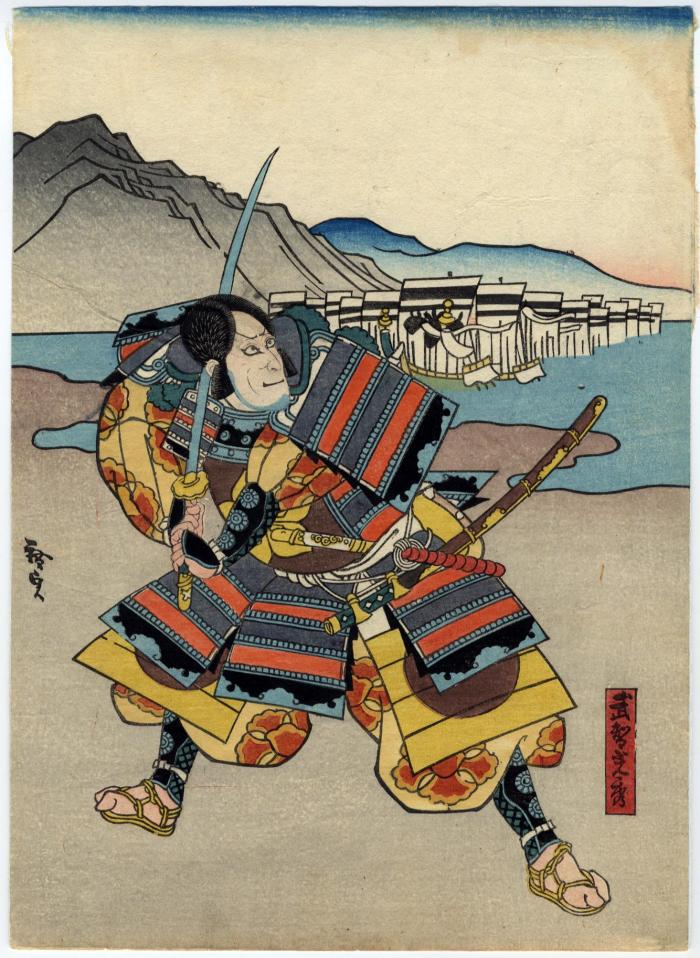Utagawa Hirosada (歌川広貞: 1810-1864) (artist 1810 – 1864)
Takechi Mitsuhide [武智光秀} - left-hand panel of a diptych illustrating the Taikōki
ca 1850
7.125 in x 9.875 in (Overall dimensions) Japanese woodblock print
Signed: Hirosada (広貞)
The Public Library of Cincinnati and Hamilton County - the whole diptych The Taikōki (太閤記) is a chronicle of the life of Toyotomi Hideyoshi. The image of Hideyoshi is shown in the right-hand panel of the diptych, but not in the Lyon Collection. Among the motifs shown on his robes is a rendition of his standard with multiple gourds linked to each other, his own personal crest.
Takechi Mitsuhide's crest or mon is the bellflower (kikyō - 桔梗) which can be seen on this clothing.
****
The curatorial files from the Public Library of Cincinnati and Hamilton County state:
"Chuban diptych; Print depicts Jitsukawa Ensaburō as Mashiba Hisayoshi and Nakamura Urtamemon [sic], IV as Takechi Mitsuhida [sic]."
****
The historical Akechi Mitsuhide
Elena Varshavskaya wrote: "On the 2nd day of the 6th month of the 10th year of the Tenshō era (21 June 1582), the warlord Oda Nobunaga, who controlled about one third of Japan, was attacked by his vassal Akechi Mitsuhide at the Honnōji temple in Kyoto. Overwhelmed by the larger forces of the attackers, Oda Nobunaga met his fate amidst the burning ruins of the temple. Akechi was not the only one to turn against his master. In Japan in the 16th century, as regional lords fought for political supremacy over the entire nation, such acts of treachery were common occurrences. Akechi's assault was different because it resulted in many significant changes in the political landscape of Japan. Nobunaga's death opened the way for Toyotomi Hideyoshi, another of his vassals, to establish hegemony over Japan. Hideyoshi, a samurai of modest origin, was endowed with extraordinary talents both as a military commander and as a politician. On joining Oda Nobunaga's service, Hideyoshi quickly became his trusted vassal. By the time of Nobunaga' s sudden death, Hideyoshi was one of the most powerful warlords and influential political figures in Japan. The news of the fatal events in Kyoto reached Hideyoshi when he was fighting far away in the western part of the country. Understanding that an immediate victory over the 'traitor' would dramatically increase his chances of becoming Nobunaga's political heir, he hastened back to the capital. Eleven days after the Honnōji affair, Hideyoshi completely routed Akechi, who was killed by villagers as he fled the scene of the battle."
Note that the curatorial files at the British Museum state: "Mashiba Hisayoshi was the name used by kabuki theatrical convention for the character Hashiba Hideyoshi, that is, the military leader Toyotomi Hideyoshi (1536–98)." Takechi Mitsuhide is actually Akechi Mitsuhide.
warrior prints (musha-e - 武者絵) (genre)
Kyōto-Osaka prints (kamigata-e - 上方絵) (genre)
